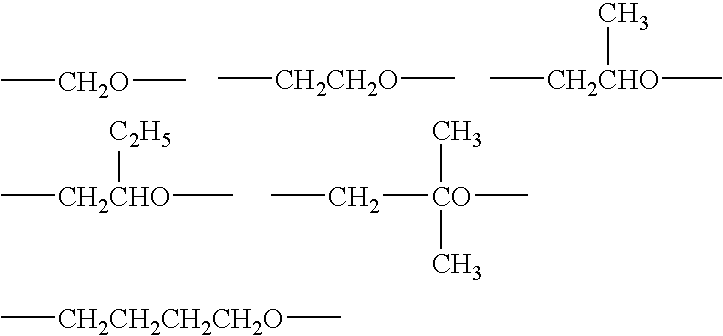Curing composition with improved heat resistance
a technology of curable compositions and compositions, applied in the field of curable compositions, can solve the problems of insufficient heat resistance, toxic organotin catalysts having carbon-tin bonds, and largely degraded physical properties of cured articles, and achieve excellent heat resistance and curability
- Summary
- Abstract
- Description
- Claims
- Application Information
AI Technical Summary
Benefits of technology
Problems solved by technology
Method used
Image
Examples
examples
[0162] The present invention will be described below in more detail with reference to examples, but the present invention is not limited only to these examples.
synthesis example 1
[0172] By use of a polyoxypropylene triol having a molecular weight of about 3,000 as an initiator and zinc hexacyanocobaltate-glyme complex as a catalyst, polymerization of propylene oxide was carried out to yield a hydroxy group-terminated trifunctional polypropylene oxide having a number average molecular weight of about 26,000 (a molecular weight relative to polystyrene standards as measured by using an HLC-8120 GPC manufactured by Tosoh Corp. as a liquid delivery system, a column of TSK-GEL H-type manufactured by Tosoh Corp., and THF as a solvent).
[0173] To 100 parts by weight of the obtained hydroxy group-terminated polypropylene oxide, 2.1 parts by weight of γ-isocyanatepropyltrimethoxysilane was added, and the mixture was allowed to react at 90° C. for 5 hours to yield a trimethoxysilyl group-terminated polyoxypropylene polymer (A-1). On the basis of the measurement by 1H-NMR (measured in CDCl3 as solvent by using a JNM-LA400 spectrometer manufactured by JEOL Ltd.), it was ...
synthesis example 2
[0176] By use of a polyoxypropylene diol having a molecular weight of about 2,000 as an initiator and zinc hexacyanocobaltate-glyme complex as a catalyst, polymerization of propylene oxide was carried out to yield a hydroxy group-terminated bifunctional polypropylene oxide (this will be referred to as the polymer P) having a number average molecular weight of about 25,500 (a molecular weight relative to polystyrene standards as measured by using an HLC-8120 GPC manufactured by Tosoh Corp. as a liquid delivery system, a column of TSK-GEL H-type manufactured by Tosoh Corp., and THF as a solvent).
[0177] To 100 parts by weight of the polymer P, 1.9 parts by weight of γ-isocyanatepropyltrimethoxysilane was added, and the mixture was allowed to react at 90° C. for 5 hours to yield a trimethoxysilyl group-terminated polyoxypropylene polymer (A-2). On the basis of the measurement by 1H-NMR (measured in CDCl3 as solvent by using a JNM-LA400 spectrometer manufactured by JEOL Ltd.), it was fo...
PUM
| Property | Measurement | Unit |
|---|---|---|
| Percent by mass | aaaaa | aaaaa |
| Percent by mass | aaaaa | aaaaa |
| Weight | aaaaa | aaaaa |
Abstract
Description
Claims
Application Information
 Login to View More
Login to View More - R&D
- Intellectual Property
- Life Sciences
- Materials
- Tech Scout
- Unparalleled Data Quality
- Higher Quality Content
- 60% Fewer Hallucinations
Browse by: Latest US Patents, China's latest patents, Technical Efficacy Thesaurus, Application Domain, Technology Topic, Popular Technical Reports.
© 2025 PatSnap. All rights reserved.Legal|Privacy policy|Modern Slavery Act Transparency Statement|Sitemap|About US| Contact US: help@patsnap.com



